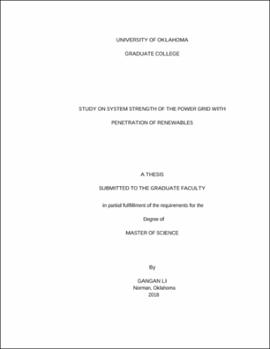| dc.description.abstract | The global demand for renewable energy presents the trend of accelerating growth in recent years due to depletion of fossil fuels and potential environmental problems. Integration of geographic dispersed renewable energy sources (RES) into a power system focuses on the incorporation of such kind of sources in a reliable and economic way while maintaining the grid integrity, reliability and load deliverability. However, increasing penetration of power electronic converter (PEC) based RES such as wind, solar and battery storage plants equipped with fast-acting control systems to the weak points of a power system could alter the system characteristics and challenge equipment manufacturers, system planners and operators. This challenge comes from the fact that connecting these RES to the weaker portions of the system may result in potential issues related to voltage stability and quality. In the worst conditions, such system stability issues could be wide-spread and lead to loss of generation and/or damage of RES equipment if the protection measures are not adequately implemented.
System strength is one of the important concerns in the integration of RES. The strength of a power system at the point of interconnection (POI) of RES can be regarded as the ability of a system to maintain its voltage stability and quality. Recently, short circuit ratio (SCR) has been used to evaluate the system strength at the POI of RES. However, this commonly used method does not consider the interactions among RES, which may lead to an overly-optimistic result. To account for the effect of such interactions on the system strength, several improved methods were developed, such as weighted SCR (WSCR) proposed by ERCOT and composite SCR (CSCR) proposed by GE. But the WSCR and CSCR methods do not take into consideration the real electrical connections among RES, which may not reflect the actual system strength at each individual POI of RES. To overcome the defeats in previous three methods, site-dependent SCR (SDSCR) has been proposed, this new method can not only be used to evaluate the system strength in terms of the distance to voltage stability limit, but also reflect the system strength at each individual point connected to RES.
In this thesis, a number of studies are conducted to demonstrate the efficacy and accuracy of SDSCR method in various applications. To validate the efficacy of SDSCR method, a simulated comparison of this new method with other three methods with respect to voltage stability limit was implemented. Moreover, several studies related to applications of SDSCR method were designed, the accuracy of this method was further validated in transfer capability calculation and it also be used to investigate the impact of grid structure on system strength. Finally, a designed procedure for cascading line outages was employed using different perspective to identify the weakest area in a system and compare the results with that obtained by system strength evaluation.
The results of the studies suggest that SDSCR method can effectively evaluate the system strength at each individual point connected to RES in terms of the distance to voltage stability limits. Also, this new method can accurately estimate the transfer capability without compromising the lower voltage limit under normal operating conditions. | en_US |
